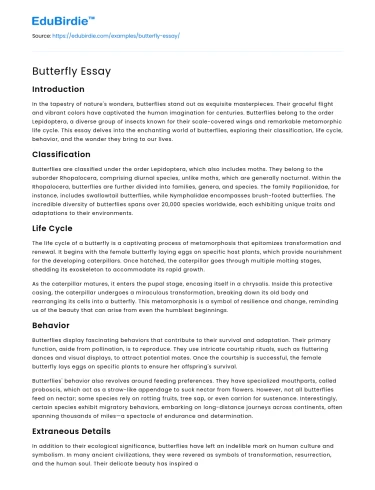Introduction
In the tapestry of nature's wonders, butterflies stand out as exquisite masterpieces. Their graceful flight and vibrant colors have captivated the human imagination for centuries. Butterflies belong to the order Lepidoptera, a diverse group of insects known for their scale-covered wings and remarkable metamorphic life cycle. This essay delves into the enchanting world of butterflies, exploring their classification, life cycle, behavior, and the wonder they bring to our lives.
Classification
Butterflies are classified under the order Lepidoptera, which also includes moths. They belong to the suborder Rhopalocera, comprising diurnal species, unlike moths, which are generally nocturnal. Within the Rhopalocera, butterflies are further divided into families, genera, and species. The family Papilionidae, for instance, includes swallowtail butterflies, while Nymphalidae encompasses brush-footed butterflies. The incredible diversity of butterflies spans over 20,000 species worldwide, each exhibiting unique traits and adaptations to their environments.
Save your time!
We can take care of your essay
- Proper editing and formatting
- Free revision, title page, and bibliography
- Flexible prices and money-back guarantee
Life Cycle
The life cycle of a butterfly is a captivating process of metamorphosis that epitomizes transformation and renewal. It begins with the female butterfly laying eggs on specific host plants, which provide nourishment for the developing caterpillars. Once hatched, the caterpillar goes through multiple molting stages, shedding its exoskeleton to accommodate its rapid growth.
As the caterpillar matures, it enters the pupal stage, encasing itself in a chrysalis. Inside this protective casing, the caterpillar undergoes a miraculous transformation, breaking down its old body and rearranging its cells into a butterfly. This metamorphosis is a symbol of resilience and change, reminding us of the beauty that can arise from even the humblest beginnings.
Behavior
Butterflies display fascinating behaviors that contribute to their survival and adaptation. Their primary function, aside from pollination, is to reproduce. They use intricate courtship rituals, such as fluttering dances and visual displays, to attract potential mates. Once the courtship is successful, the female butterfly lays eggs on specific plants to ensure her offspring's survival.
Butterflies' behavior also revolves around feeding preferences. They have specialized mouthparts, called proboscis, which act as a straw-like appendage to suck nectar from flowers. However, not all butterflies feed on nectar; some species rely on rotting fruits, tree sap, or even carrion for sustenance. Interestingly, certain species exhibit migratory behaviors, embarking on long-distance journeys across continents, often spanning thousands of miles—a spectacle of endurance and determination.
Extraneous Details
In addition to their ecological significance, butterflies have left an indelible mark on human culture and symbolism. In many ancient civilizations, they were revered as symbols of transformation, resurrection, and the human soul. Their delicate beauty has inspired artists, poets, and writers throughout history, finding their way into countless paintings, poems, and stories.
Moreover, butterflies have become a focal point in conservation efforts, as their populations face threats due to habitat loss, climate change, and pesticides. Organizations and individuals alike are working tirelessly to protect butterfly habitats, implement sustainable practices, and raise awareness about their importance in maintaining ecosystem balance.
These captivating insects have also contributed to scientific discoveries. The study of butterfly wing patterns, for example, has led to insights in the fields of optics and biomimicry, inspiring innovations in reflective displays and camouflage technologies. Researchers continue to explore the secrets hidden in their delicate wings, uncovering new possibilities for human technology.
Conclusion
In conclusion, butterflies are nature's enchanting works of art, captivating us with their metamorphic journey, vibrant colors, and mesmerizing flight. Their classification as Lepidoptera showcases their uniqueness among insects, and their diverse life cycles and behaviors highlight their resilience and adaptability.
Beyond their ecological importance, butterflies hold deep symbolic and cultural significance in various societies, representing hope, change, and the ephemeral nature of life. They have become emblematic of conservation efforts, reminding us of the delicate balance of nature and our responsibility to protect these fragile creatures.
As we continue to marvel at these majestic metamorphs, let us be reminded of the interconnectedness of all living beings and the intricate web of life that sustains us. The world of butterflies beckons us to embrace change, cherish fleeting moments of beauty, and cultivate a deeper appreciation for the wonders of the natural world that surround us. Through our collective efforts, we can ensure that future generations will continue to witness the graceful flight of butterflies, a symbol of hope and renewal in our ever-changing world.






 Stuck on your essay?
Stuck on your essay?

